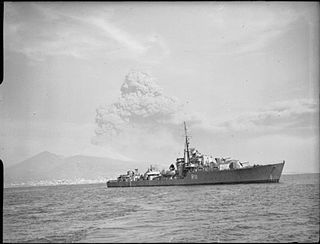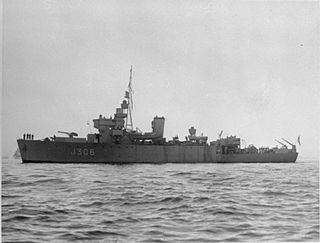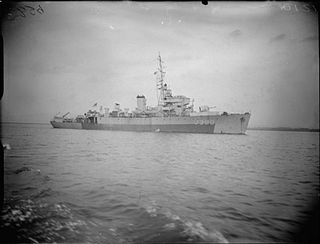
ORP Orkan, formerly HMS Myrmidon, was an M-class destroyer of the Polish Navy during World War II. Orkan is Polish for "hurricane".
HMS Owen was a Bay-class frigate built for the Royal Navy during World War 2.

HMS Terpsichore was a T-class destroyer built for the Royal Navy during the Second World War.

HMS Tumult was a T-class destroyer built for the Royal Navy during the Second World War.

HMS Tyrian was a S-class destroyer built for the Royal Navy during the Second World War.

HMS Scourge was an S-class destroyer built for the Royal Navy during the Second World War. The ship was sold to the Netherlands postwar, where it saw action in the Korean War and the West New Guinea dispute.

HMS Chiddingfold (L31) was a Type II Hunt-class destroyer of the Royal Navy. She was leased to the Indian Navy in 1952 where she served as INS Ganga (D94).

HMS Hound was a reciprocating engine-powered Algerine-class minesweeper built for the Royal Navy during the Second World War. She survived the war and was scrapped in 1962.
HMIS Khyber (J190) was a Bangor-class minesweeper built for the Royal Navy, but transferred to the Royal Indian Navy (RIN) during the Second World War.

SAS Good Hope was one of three Loch-class frigates in the South African Navy (SAN). It was built as HMS Loch Boisdale (K432) for the Royal Navy during World War II, but was transferred to the SAN before completion in 1944 and renamed as HMSAS Good Hope. The ship was assigned to convoy escort duties in 1945, but did not encounter any enemy ships before the end of the war.

HMS Cavendish was one of eight C-class destroyers built for the Royal Navy during the Second World War. Commissioned in late 1944, she was built as a flotilla leader with additional accommodation for staff officers. The ship was assigned to the Home Fleet in 1945 after working up where she escorted capital ships of the fleet. Cavendish was sold for scrap in 1967.

HMS Caesar was one of thirty-two C-class destroyers built for the Royal Navy during the Second World War, a member of the eight-ship Ca sub-class. Commissioned in 1944, she was built as a flotilla leader with additional accommodation for staff officers. The ship was assigned to Home Fleet during 1944–1945 and escorted one Arctic convoy as well as the capital ships of the fleet.

HMS Cheviot was one of thirty-two C-class destroyers built for the Royal Navy during the Second World War, a member of the eight-ship Ch sub-class. Completed after the war, she was sold for scrap in 1962.

HMSAS Natal was one of three Loch-class frigates in the South African Navy (SAN). It was built as HMS Loch Cree (K430) for the Royal Navy during World War II, but was transferred to the SAN before completion in 1945 and renamed as HMSAS Natal. Just hours after finishing fitting out, the ship sank a German submarine off the coast of Scotland in early 1945. It was assigned convoy escort duties for the remaining few months of the war in Europe. Natal had her anti-aircraft armament reinforced for service in the Far East after arriving in South Africa in June. In September–October, the ship participated in the reoccupation of British Malaya before returning home the following month.

SAS Transvaal was one of three Loch-class frigates in the South African Navy (SAN). She was built as HMS Loch Ard (K602) for the Royal Navy during World War II, but was transferred to the SAN in 1944 before completion and renamed as HMSAS Transvaal. The ship was completed shortly after the German surrender in May 1945 and did not participate in the war.

HMS Fly (J306) was a reciprocating engine-powered Algerine-class minesweeper during the Second World War. She survived the war and was sold to Iran in 1949 as IISPalang.

HMS Felicity (J369) was a reciprocating engine-powered Algerine-class minesweeper during the Second World War.

HMS Jewel (J390) was a steam turbine-powered Algerine-class minesweeper during the Second World War.

HMS Lennox (J276) was a reciprocating engine-powered Algerine-class minesweeper during the Second World War.

HMS Niger (J442) was a reciprocating engine-powered Algerine-class minesweeper during the Second World War.


















